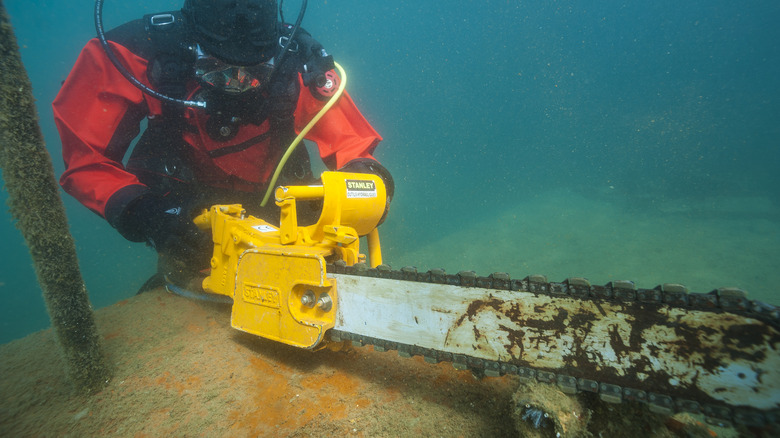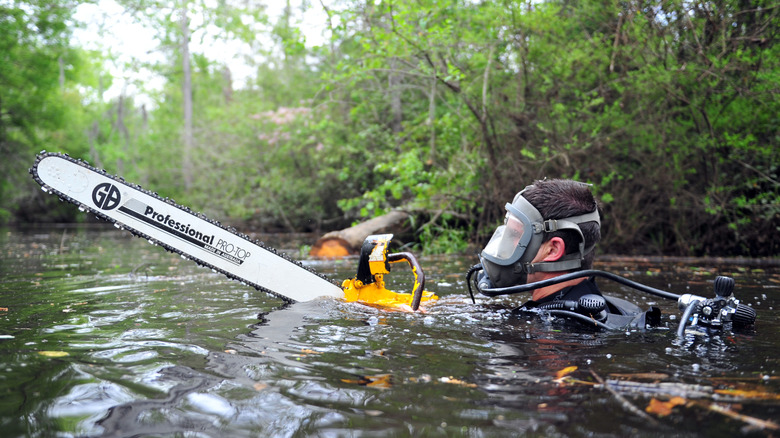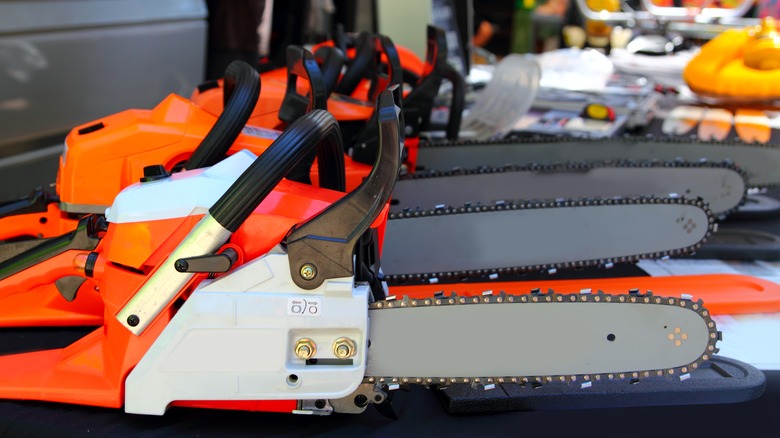Underwater Chainsaws: What They're Used For (And Why They Cost So Much)
We may receive a commission on purchases made from links.
There's a tool for every job. If you're looking to change your car's coolant, try one of the most underrated tools at Advance Auto Parts, the coolant funnel. If you need to clear lint out of your clothes dryer's vent, try a dryer-vent cleaning kit. And when you're ready to replace the pilings on your dock, you'll need an underwater chainsaw.
Underwater chainsaws are also called "aquatic chainsaws." As you probably expect, they work even when entirely submerged in water. But although aquatic chainsaws might sound exceedingly specialized, they can be used for a wide variety of tasks. After all, a chainsaw that works under the water typically works above water, as well.
Two major qualities separate underwater chainsaws from regular chainsaws. While the chainsaws most folks are familiar with are pneumatic (gas-powered) and electric, combustion and electricity don't work well underwater. These specialized chainsaws, on the other hand, can be either hydraulic or pneumatic, allowing them to be used while they're submerged. The other major quality that differentiates aquatic chainsaws from standard chainsaws is the price tag. You can score an affordable chainsaw for about 100 bucks, such as this electric one from Black+Decker. And by following some maintenance tricks and tips, that cheap chainsaw should last you many years — as long as you use it above the waterline.
However, aquatic chainsaws can cost quite a bit more. For example, this option from Stanley is over $1,800, and that's before you factor in the costs of replacement chains, hose whips, and couplers. So why are hydraulic underwater chainsaws so expensive? First, consider what this tool really is.
What is an underwater chainsaw?
Regardless of how underwater chainsaws are powered, they operate in similar ways. As with regular chainsaws, that chain is affixed with blades to cut through wood, and some can even handle concrete, metal, and plastic. They don't always have the same rip-roaring power or portability as gas-powered chainsaws, but they're invaluable for underwater applications. Their waterproof encasings are better equipped for wet conditions, so they also serve well in the mud and rain. Some models even have diamond-grit teeth to prevent kick-backs and jams when you're slicing away at extra-hard materials.
Underwater chainsaws are primarily used for cutting the wooden pilings of docks, bridges, and other submerged structures. It sounds niche, but it's actually quite common. The water is a strong catalyst for rotting wood and eroding docks, so constant maintenance is critical.
Many underwater chainsaws have extra safety features. For example, they often have cooling systems, powered by either water or oil. Options with hand guards and chain brakes prevent broken chains from taking off a hand. Furthermore, you can expect interlocking safety triggers to help minimize accidents.
[Featured image by US Navy via Wikimedia Commons | Cropped | Public Domain by Title 17 of the US Code]
Types of underwater chainsaws
Not every chainsaw can be used under the water, and not every model is the same. In fact, there are various features (and prices) worth considering before you take the plunge.
Almost all types are equipped to cut through wood, but if you need something to cut extra-hard woods, plastics, metals, concrete, and other tough materials, you'll have to go with a diamond-grit blade, like this one from Hopkins. There's also this model from Stanley, which is specifically designed for cutting masonry and concrete.
For cutting just wood, you don't need to go with a model quite as expensive as the above examples. However, you'll still need to consider the length of the blade (or "bar"). To make the job quicker, you should buy a chainsaw with a length greater than the diameter of the pilings you'll be cutting. For thick pilings like those on bridges, docks, and piers, the diameter can be as great as 12 inches. Typical models range in size between 10 and 30 inches. For example, if your piling is 10 inches in diameter, a 16-inch chainsaw like this one from U.S. Saws will offer plenty of length.
Thus, the price you pay for an underwater chainsaw depends entirely on your needs. Heavy-duty models that can tear through tough materials are costly, while wood-only options are quite a bit cheaper. Nonetheless, whichever model you choose, you can cut with confidence knowing that your hydraulic power tool can get wet.


